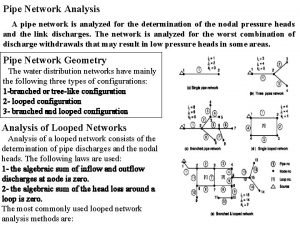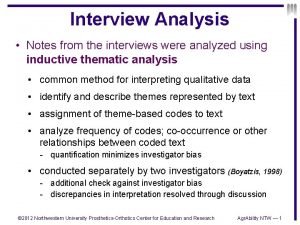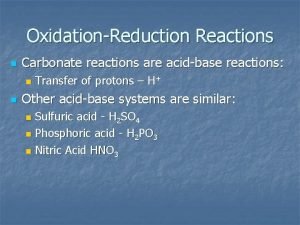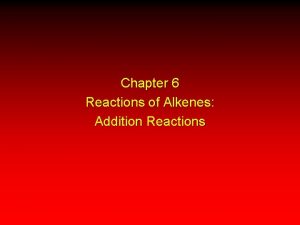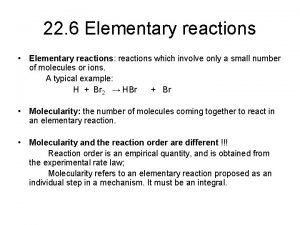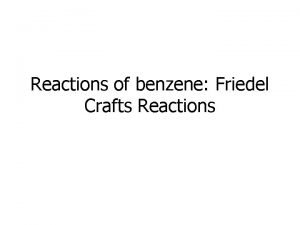Reactions In previous lectures materials flows were analyzed











- Slides: 11

Reactions In previous lectures materials flows were analyzed as steady-state processes. Time was not a variable. In many processes time variability is important.

Reaction Rates A mathematical expression describing the rate at which the mass or volume of some material A is changing with time T is: d. A/dt = r r = reaction rate Zero Order Reaction rate, r, is a constant: r=k So: d. A/dt = k

First Order Reactions The change of the component is proportional to the amount of the component present, or: r = k. A k is called the reaction rate constant the units on k are time-1 in the case of a first order reaction Second Order Reaction The change of the component is proportional to the square of the amount of the component present r = k A 2 So: d. A/dt = k A 2

In terms of concentration: Zero Order Units on k First Order Units on k Second Order Units on k d. C/dt = k (mass/length 3)/time or concentration/time d. C/dt = k. C (d. C/dt)/C time-1 d. C/dt = k C 2 (d. C/dt)/C 2 or concentration-1 time-1 length 3/(mass. time)

Zero Order Reactions If A = A 0 when t = 0 then the reaction rate equation can be solved by integration: d. C/dt = k A d. C = k A 0 t dt 0 If the concentration is increasing k is positive If the concentration is decreasing k is negative

Increasing concentration: A d. C = k A 0 t dt 0 C = C 0 + kt Decreasing concentration: A t d. C = - k A 0 dt 0 C = C 0 – k t

Example Nitrogen gas is used to strip oxygen from water before an aeration test is performed. The following data were obtained during a similar test. How long will it take before the oxygen concentration is less than 0. 5 mg/L? From the graph k = 0. 075 mg/(L. s) C = C 0 – k 0. 5 = 9. 5 – (0. 075)*t t = 120 s

First Order Reactions d. C/dt = r = k C If A = A 0 when t = o: A t d. C/C = k A 0 dt 0 ln(A/A 0) = k t or A/A 0 = ekt or ln. A – ln. A 0 = kt Again k is positive when the concentration increases k is negative when the concentration decreases

ln A – ln A 0 = k t ln A = k t + ln A 0 y = mx+ b So, if we plot (ln A) on the y-axis and (t) on the x-axis The slope is the reaction rate constant, k, and the intercept is ln A 0

Example When the BOD of a wastewater is caused by particulate material its removal may often be described as first order. Consider the following data which were obtained from a batch test of a food processing waste water: How long will it take to reduce the BOD to 30 mg/L? What will the BOD be after 5 days?

So, k = 0. 011 hr-1 Now: ln(A/A 0) = -kt t = [ln(A/A 0)]/-k t = [ln(30/220)]/(-0. 011) = 181 hr = 7. 55 days Also: [BOD] = [BOD 0] e-kt = (220) e-(0. 011)(5 x 24) = 58. 8 mg/L
 Chemical reactions section 2 classifying chemical reactions
Chemical reactions section 2 classifying chemical reactions Chemical reactions section 3 reactions in aqueous solutions
Chemical reactions section 3 reactions in aqueous solutions Section 2 classifying chemical reactions worksheet answers
Section 2 classifying chemical reactions worksheet answers Unit 5 chemical reactions answers
Unit 5 chemical reactions answers Example of oxidation reduction reaction
Example of oxidation reduction reaction Move in a circular or semi-circular direction.
Move in a circular or semi-circular direction. Features of system analysis
Features of system analysis Identify community issues and problems
Identify community issues and problems Pipe network analysis
Pipe network analysis Lake or enclosure fingerprint
Lake or enclosure fingerprint An item with zero discriminating power must be retained
An item with zero discriminating power must be retained Formalism is sometimes analyzed and written as
Formalism is sometimes analyzed and written as








